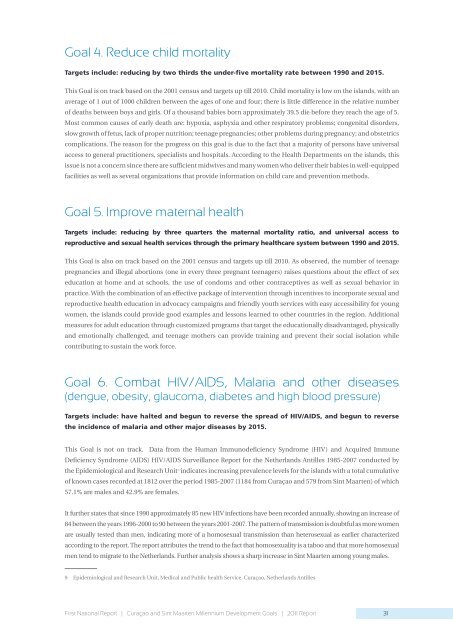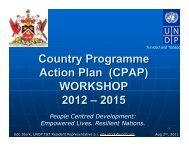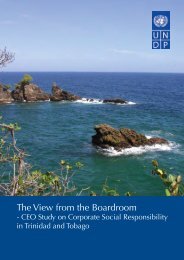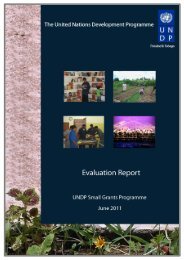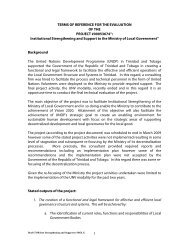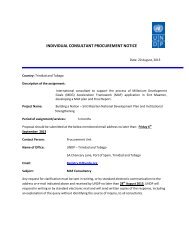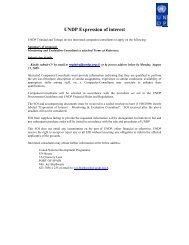Curaçao & Sint Maarten - UNDP Trinidad and Tobago
Curaçao & Sint Maarten - UNDP Trinidad and Tobago
Curaçao & Sint Maarten - UNDP Trinidad and Tobago
Create successful ePaper yourself
Turn your PDF publications into a flip-book with our unique Google optimized e-Paper software.
Goal 4. Reduce child mortality<br />
Targets include: reducing by two thirds the under-five mortality rate between 1990 <strong>and</strong> 2015.<br />
This Goal is on track based on the 2001 census <strong>and</strong> targets up till 2010. Child mortality is low on the isl<strong>and</strong>s, with an<br />
average of 1 out of 1000 children between the ages of one <strong>and</strong> four; there is little difference in the relative number<br />
of deaths between boys <strong>and</strong> girls. Of a thous<strong>and</strong> babies born approximately 39.5 die before they reach the age of 5.<br />
Most common causes of early death are: hypoxia, asphyxia <strong>and</strong> other respiratory problems; congenital disorders,<br />
slow growth of fetus, lack of proper nutrition; teenage pregnancies; other problems during pregnancy; <strong>and</strong> obstetrics<br />
complications. The reason for the progress on this goal is due to the fact that a majority of persons have universal<br />
access to general practitioners, specialists <strong>and</strong> hospitals. According to the Health Departments on the isl<strong>and</strong>s, this<br />
issue is not a concern since there are sufficient midwives <strong>and</strong> many women who deliver their babies in well-equipped<br />
facilities as well as several organizations that provide information on child care <strong>and</strong> prevention methods.<br />
Goal 5. Improve maternal health<br />
Targets include: reducing by three quarters the maternal mortality ratio, <strong>and</strong> universal access to<br />
reproductive <strong>and</strong> sexual health services through the primary healthcare system between 1990 <strong>and</strong> 2015.<br />
This Goal is also on track based on the 2001 census <strong>and</strong> targets up till 2010. As observed, the number of teenage<br />
pregnancies <strong>and</strong> illegal abortions (one in every three pregnant teenagers) raises questions about the effect of sex<br />
education at home <strong>and</strong> at schools, the use of condoms <strong>and</strong> other contraceptives as well as sexual behavior in<br />
practice. With the combination of an effective package of intervention through incentives to incorporate sexual <strong>and</strong><br />
reproductive health education in advocacy campaigns <strong>and</strong> friendly youth services with easy accessibility for young<br />
women, the isl<strong>and</strong>s could provide good examples <strong>and</strong> lessons learned to other countries in the region. Additional<br />
measures for adult education through customized programs that target the educationally disadvantaged, physically<br />
<strong>and</strong> emotionally challenged, <strong>and</strong> teenage mothers can provide training <strong>and</strong> prevent their social isolation while<br />
contributing to sustain the work force.<br />
Goal 6. Combat HIV/AIDS, Malaria <strong>and</strong> other diseases<br />
(dengue, obesity, glaucoma, diabetes <strong>and</strong> high blood pressure)<br />
Targets include: have halted <strong>and</strong> begun to reverse the spread of HIV/AIDS, <strong>and</strong> begun to reverse<br />
the incidence of malaria <strong>and</strong> other major diseases by 2015.<br />
This Goal is not on track. Data from the Human Immunodeficiency Syndrome (HIV) <strong>and</strong> Acquired Immune<br />
Deficiency Syndrome (AIDS) HIV/AIDS Surveillance Report for the Netherl<strong>and</strong>s Antilles 1985-2007 conducted by<br />
the Epidemiological <strong>and</strong> Research Unit9 indicates increasing prevalence levels for the isl<strong>and</strong>s with a total cumulative<br />
of known cases recorded at 1812 over the period 1985-2007 (1184 from <strong>Curaçao</strong> <strong>and</strong> 579 from <strong>Sint</strong> <strong>Maarten</strong>) of which<br />
57.1% are males <strong>and</strong> 42.9% are females.<br />
It further states that since 1990 approximately 85 new HIV infections have been recorded annually, showing an increase of<br />
84 between the years 1996-2000 to 90 between the years 2001-2007. The pattern of transmission is doubtful as more women<br />
are usually tested than men, indicating more of a homosexual transmission than heterosexual as earlier characterized<br />
according to the report. The report attributes the trend to the fact that homosexuality is a taboo <strong>and</strong> that more homosexual<br />
men tend to migrate to the Netherl<strong>and</strong>s. Further analysis shows a sharp increase in <strong>Sint</strong> <strong>Maarten</strong> among young males.<br />
9 Epidemiological <strong>and</strong> Research Unit, Medical <strong>and</strong> Public health Service, <strong>Curaçao</strong>, Netherl<strong>and</strong>s Antilles<br />
First National Report | <strong>Curaçao</strong> <strong>and</strong> <strong>Sint</strong> <strong>Maarten</strong> Millennium Development Goals | 2011 Report<br />
31


